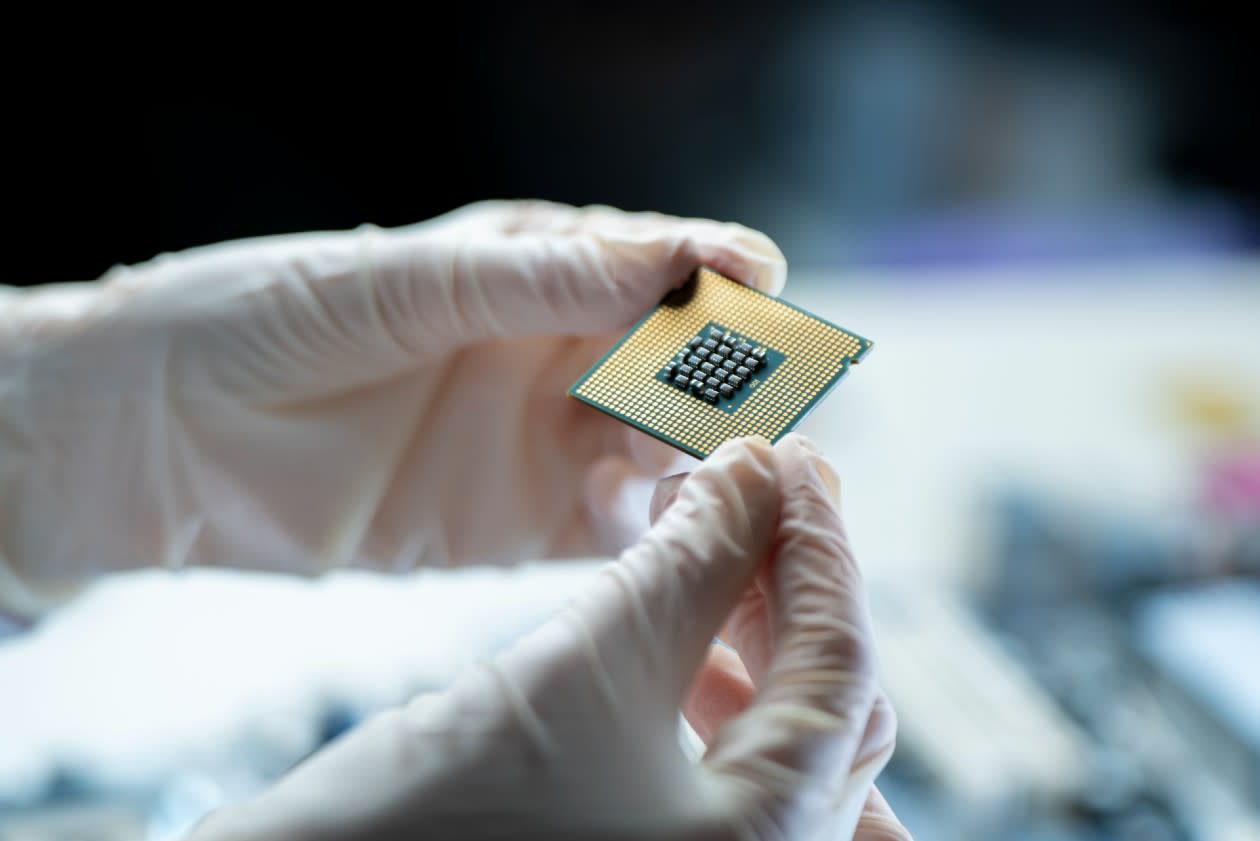ASML reported a 23% rise in second quarter revenue to €7.7bn (€7.5bn expected). Operating income rose 45% to €2.7bn (€2.4bn expected) with a margin of 34.6%. New orders were broadly flat at €5.5bn.
Performance was driven by upgrades to the existing installed base, one-off cost benefits, and a less severe tariff impact than expected.
Free cash flow fell 17% to €319mn and there was net cash on the balance sheet of €3.6bn.
Management expects third quarter revenue to land between €7.4-7.9bn and operating income around €2.4bn (analysts had been expecting €8.2bn and €2.7bn respectively).
Looking further ahead, growth in 2026 is uncertain at this stage, with management calling out “increasing uncertainty driven by macro-economic and geopolitical developments”.
An interim dividend of €1.60 was announced, payable in August, and around €1.4bn worth of shares were bought back over the period.
The shares were down 6.4% in early trading.
Our view
ASML reported a solid quarter but cautioned that 2026 growth is uncertain. Analysts were expecting 7% revenue growth for 2026, but forecasts may be revised downward following today’s remarks.
Tariffs and broader economic uncertainty are the key issues, and ASML’s customers have flagged similar concerns. ASML has some exposure to US manufacturing and imports/exports, but it’s relatively insulated to direct tariffs. Second order effects like inflation or recessions are the bigger risk. ASML is far removed from the end consumer but will still feel an impact if spending drops.
Netherlands-based ASML is the market leader in lithography machines used to make semiconductor chips. Without these, you wouldn't have the chips that power the latest phones, computers or even cars. It continues to push the boundaries of the most advanced tech and competitors look a long way off catching up.
ASML’s dominant position and technical expertise allow it to bank a sizeable chunk of revenue into profit. There’s room for profitability to improve further as services and upgrades for the installed base of machines become a bigger part of the business.
Aside from tariff concerns, the market is mixed, with a slow recovery in consumer electronics and the reassessment of investment plans by some key chip manufacturers. Over the longer term, the company is well-placed to benefit from structural growth drivers such as artificial intelligence, increasing data volumes, and the energy transition.
The China story is also key. Given ASML relies on US manufacturing for sections of its machines, it’s subject to export restrictions. China's stockpiling of ASML's lithography machines, driven by anticipated tighter export restrictions, has boosted sales in recent years. However, this could create future challenges if restrictions intensify or China reduces purchases due to sufficient inventory.
The sector has a solid history of investing and innovating for the future, and current technological shifts could significantly accelerate that progress. ASML’s value lies in helping customers achieve higher returns on investment, and its economic moat doesn’t look like it’s under any real threat - but it needs to keep innovating to keep it that way.
Overall, we think ASML's dominant market position leaves it well-placed to benefit from long-term growth trends in the semiconductor industry. However, given the uncertain growth outlook over 2026, we think there are other names in the sector with more attractive near-term return profiles.
Environmental, social and governance (ESG) risk
The semiconductor sector is medium-risk in terms of ESG. Overall, this risk is managed adequately in Europe and North America but has considerable room for improvement in the Asia-Pacific region. Its reliance on highly-specialised workers means labour relations is one of the key risk drivers. Other risks worth monitoring include resource use, business ethics, product governance, and carbon emissions.
According to Sustainalytics, ASML’s management of material ESG issues is strong.
It is targeting net zero emissions across the value chain by 2040 with credible near-term targets in place for direct and indirect emissions. Its manufacturing sites have received an internationally recognised certification, which suggests a strong environmental management system. There’s also a commitment to reducing hazardous waste. ASML requires a highly skilled workforce and scores well on employee management, with turnover falling from 6% to 3.6% in 2023. Despite its dominant position it has not had any significant antitrust controversies, with its market position protected by innovation and complexity rather than anticompetitive practices.
ASML key facts
All ratios are sourced from LSEG Datastream, based on previous day’s closing values. Please remember yields are variable and not a reliable indicator of future income. Keep in mind key figures shouldn’t be looked at on their own – it’s important to understand the big picture.
This article is not advice or a recommendation to buy, sell or hold any investment.No view is given on the present or future value or price of any investment, and investors should form their own view on any proposed investment.This article has not been prepared in accordance with legal requirements designed to promote the independence of investment research and is considered a marketing communication.Non - independent research is not subject to FCA rules prohibiting dealing ahead of research, however HL has put controls in place(including dealing restrictions, physical and information barriers) to manage potential conflicts of interest presented by such dealing.Please see our full non - independent research disclosure for more information.


